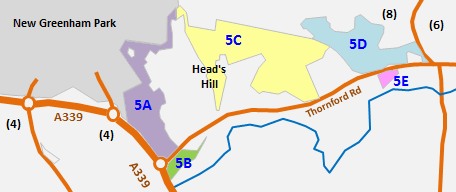
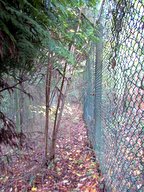
Compartment 5 is the southeastern area of the common, comprising land south and east of New Greenham Park, extending eastwards as far as Old Thornford Road and including two areas on the south side of Thornford Road. The five subcompartments are separated and partly defined by roads, properties and areas which are not part of the common.
Of the five, only subcompartments 5C and 5D are easily accessible from the main common (the narrow connection in the north of 5A is overgrown and necessitates climbing at least one fence). All of 5C except the southern part of Head's Hill, and all of 5D are within the stock fence and accessible for grazing.
General description and evaluation of ecology
This is a large and complex mixture of habitats. This area, formed around the valley slopes and several wet gullies, contains willow, alder and wet birch woodland, oak woodland, heathland, neutral grassland and several ponds. Features found within this diverse patchwork of habitats include swathes of sphagnum moss and juncus in the gullies, a badger sett, breeding areas for nightingale, and a rich woodland flora. Dragonflies frequent the ponds, with the wet gully in compartment 5C regularly attracting golden ringed dragonfly. Heathland areas are rich and have potential for expansion, some containing adder, slow worm and common lizard.
BAP habitats
- Lowland heathland (5A, 5C, 5D)
- Ponds (5C, 5D)
- Wet woodland (5B, 5D)
Higher Level Stewardship
Options exist for Sub compartments 5A, 5C and 5D
Overall management objectives
A combination of maintenance and restoration of heath from secondary woodland will occur in this area. Where mature or relict lowland heathland exists this should be the priority habitat and expanded where possible and reasonable. A quantity of scrub and mature trees will be retained for diversity. Compartment 5 should also contain a diverse structure, to be created by mowing and scraping. The woodlands will be minimally managed, with the annual creation of small glades to diversify the canopy and control non native or invasive species like rhododendron, sycamore and Himalayan balsam. An opportunity to open existing glades, particularly along the cable rides, and scalloping into the woodland edges will increase diversity and link areas of heathland and open glades.
Subcompartment 5A (8.4 ha) Martindale
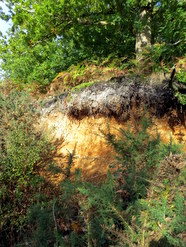
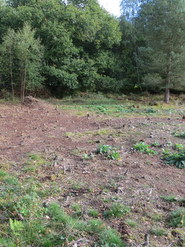
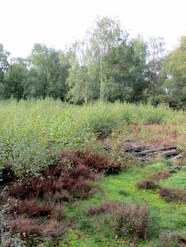
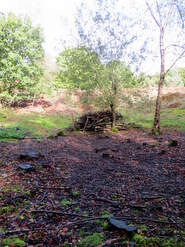
A diverse mix of habitats between New Greenham Park and Martindale farm. There are two valley head flushes with willow, alder and wet birch woodland with patches of sphagnum with the majority of the woodland dry birch and oak with bramble, hazel, holly and some non-native species. Dry Calluna heath, mature gorse and bracken occur in a large clearing in the centre of the compartment, where Dartford warbler and nightingale have been recorded. Neutral grassland also occurs on roadsides and near properties. Small excavations have provided ephemeral pools and bare gravel/sand faces, one of which is over 2 m high.
| Objective | Area | Method | Comment |
|---|---|---|---|
| 5A.1) Create a more diverse structured woodland. | Whole wooded area. | Clear very small glades by felling birch. Stack logs. Burn or stack brash where suitable and leave stumps to regenerate (i.e don't treat). Leave standing deadwood where safe. Create log piles for reptiles, invertebrates etc. 'Halo' exisiting mature oaks by removing surrounding scrub. Possibly treat stumps if adjacent to heathland, not if within woodland. Remove/reduce non native species including sycamore, cherry laurel, bamboo and rhododendron. Treat stumps. Select some for ring barking where suitable. |
Maintain woodland screen alongside paths and along the roadsides. Liaise with local residents before felling trees. Coppice gorse to encourage regrowth and improve screening. |
5A.2) Maintain existing heathland and acid grassland mosaic.HLS objective |
Main large open area in centre of compartment. | Coppice gorse in small sections each year and allow to regrow to maintain a varied structure. Cut and treat birch stumps to prevent re-growth. Mow 1/25 of the heathland each year in small blocks and create small scrapes within existing heath. Consider weed-wiping the large area of birch regrowth over relict heather, if within weed-wiping height. Control bracken by spraying and scraping to create more heathland areas. |
Mowing and scrapes can be done with a hand mower and hand tools, as such a small scale. |
| 5A.3) Increase areas of heathland and acid grassland communities where a relict flora remains under young willow or birch woodland. | Predominantly around the edge of the large opening of dry heath in centre of compartment. | Fell secondary woodland where relict heath flora exists to extend area of heath. Stumps should be treated and litter scraped in small sections to expose seed bank. Scallop edges to increase the length of the woodland/heathland boundary, and focus on steep gravel excavations. | Liaise with local residents regarding any substantial clearance. Maintain a thick woodland screen against the A339, Thornford Road and the businees park. |
Subcompartment 5B (1.4 ha)
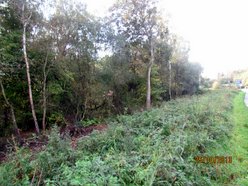
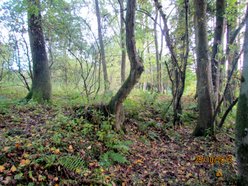
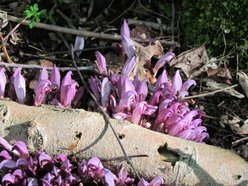
A small mixed woodland, with prominent banks, south of Thornford Road. The canopy is mainly oak and birch with maple, hawthorn, hazel, holly, a few small elms and a group of hybrid poplars. The ground flora is species-rich and includes toothwort. The lower end of Martindale stream dissects the woodland and runs along the edge through alder coppice. Himalayan balsam, formerly dominating the woodland floor, has been substantially reduced in recent years (2009 to 2013).
| Objective | Area | Method | Comment |
|---|---|---|---|
| 5B.1) Reduce dominance of Himalayan balsam | Most of the wetter areas within the woodland. | Pull or cut plants before seed develops, and repeat each year. Stack in piles away from flora of interest. | |
| 5B.2) Diversify woodland structure. | Whole subcompartment. | Coppice Alders along stream-side every couple of years. Small scale operation, one stool at a time. Encourage oak regeneration and selectively ring-bark or fell birch and sycamore. |
There is potential for a barn owl box on the edge of this woodland. The common boundary is ill-defined and would benefit from some markers. |
Subcompartment 5C (9.6 ha) Head's Hill and Goldfinch Bottom
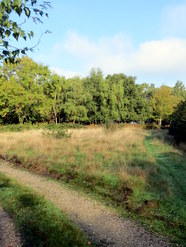
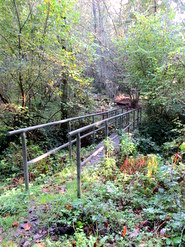
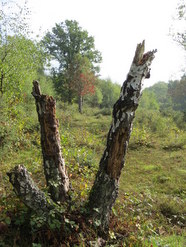
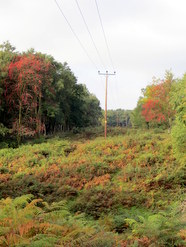
A complex area lying between the head of Martindale stream and Foxhold Farm. This area comprises a large area of mature birch woodland, mixed scrub, heath and older oak woodland with hazel and holly. There is dry heathland with bracken and gorse, predominantly under the cable rides. There are two species-rich wet valley heads, containing sphagnum and juncus communities, feeding gullies with wet birch and alder woodland. A more recent pond with good marginal flora is also present. Residential properties surround the majority of the perimeter where mown and rabbit-grazed grassland occurs, especially at Head's Hill.
| Objective | Area | Method | Comment |
|---|---|---|---|
| 5C.1) Maintain existing areas of open heath and acid grassland mosaic and continue diversifying structure. | Open heathland areas predominantly under telegraph rides. | Mow heather in small sections over a 20 to 25 year rotation. Collect and remove cuttings. Create small scrapes for 1% bare ground and pioneer heather regeneration (look at creating scrapes within scrub or bracken). Control birch, bracken, gorse scrub and brambles using chemicals if required. Maintain a dense heath/woodland edge boundary along with standing and lying deadwood. |
See Appendix 7 Heathland management. |
5C.2) Increase area of heathlandHLS objective |
Along cable ride and into birch woodland. | Fell secondary woodland where relict heath flora exists to extend area of heath. Stumps should be treated, and litter scraped in small sections to expose seed bank (or re-seeded from existing stock if required). Scallop edges to increase the length of the woodland/heathland boundary. Control brambles and bracken. | Liaise with local residents regarding any clearance. Maintain a thick woodland screen against the trackway and properties. |
| 5C.3) Create a more diverse structured woodland. | Whole wooded area. | Clear very small glades by felling trees and scrub. Stack logs. Burn or stack brash where suitable and leave stumps to regenerate. Leave standing deadwood where safe. Where remnant heath exists, treat stumps and connect with other existing heath areas. Remove some non-native species including sycamore, turkey oak (refer to appendix 4 invasive alien species) and garden introductions. Rejuvenate area of hazel coppice immediately east of the metal footbridge. Keep the two valley heads and gullies free from scrub and maintain openness of pond east of board walk. |
Maintain woodland screen alongside residences. Protect badger setts. Focus on cable rides, keeping them clear of scrub and scalloping into the ride edge. |
| 5C.4) Increase extent of acid grassland. | Head's Hill. | Control spread of bramble by mowing when necessary. Avoid well established ant hills. | |
| 5C.5) Maintain diversity of pond. | Goldfinch bottom east of board walk. | Remove silt from ¼ of the pond each year. Scallop into surround scrub. | Await Ponds Management Plan, but note possibility of creating a new pond next to board walk. |
Subcompartment 5D (8.7 ha) Brushwood Gully
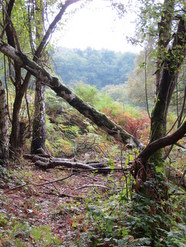
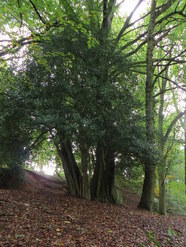
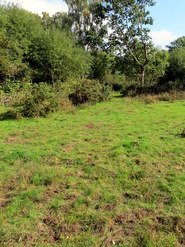
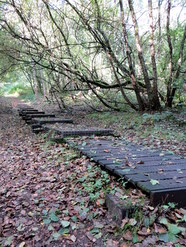
The eastern edge of compartment 5, this is a structurally complex compartment including older oak woodland with some hazel coppice, mature alder coppice in two gullies, and a mix of tall birch, alder and willow scrub in the gully heads. The woodlands have a rich flora throughout. There are open bracken tracts in cleared woodland areas. Dry and wet heath occurs on the sheltered, lower slopes within an area of secondary birch woodland and gorse scrub. There is a former balancing pond at the head of Brushwood Gully.
| Objective | Area | Method | Comment |
|---|---|---|---|
5D.1) Increase area of heathland.
HLS objective |
Expanding from existing area of heath. | Fell secondary woodland where relict heath flora exists to extend area of heath (but to be done on a very small scale each year). Stumps should be treated and litter scraped in small sections to expose seed bank (or re-seeded from existing stock if required). Scallop woodland edges to increase the length of the woodland/heathland boundary. Treat bracken along wide cable rides and encourage heather regeneration. Scallop into the ride edges. |
A significant percentage of thick scrub and brambles should be retained for nightingales. Keep glade clearance yearly and small scale. |
| 5D.2) Maintain existing areas of open heath and acid grassland mosaic and continue diversifying structure. | Open heath area. | Create small scrapes for 1% bare ground and pioneer heather regeneration (look at creating scrapes within scrub or bracken). Can be done by hand as very small sections to be done. Control birch, bracken, gorse scrub and brambles using chemicals if required. Maintain a dense heath/woodland edge boundary along with standing and lying deadwood. |
See Appendix 7 Heathland management. |
| 5D.3) Create a more diverse structured woodland. | Whole wooded area. | Clear very small glades by felling trees and scrub. Stack logs. Burn or stack brash where suitable and leave stumps to regenerate (i.e don't treat). Leave standing deadwood where safe. Where remnant heath exists, treat stumps and connect with other existing heath areas.
Remove some non native species including sycamore, turkey oak (see appendix 4 invasive alien species) and garden introductions. Coppice alder and willow at the two valley heads, and selected specimens lower down, in rotation. Keep gullies free from scrub. Ring-bark birch in valley heads. Remove selected trees in southeast of 5D to open up southward views to the North Hampshire Downs. Reduce scrub cover on south-facing bank for increased sunlight to benefit reptiles and invertebrates. Focus on cable rides, keeping them clear of scrub and scalloping into the ride edges. |
Maintain woodland screen alongside residences. Protect badger setts. Leave bracken around the setts. |
| 5D.4) Maintain openness of pond. | Top of Brushwood Gully. | Remove silt from ¼ of the pond each year. Will need to be done by hand due to difficult access for machinery. | Ponds Management Plan will advise on future management. |
Subcompartment 5E (0.4 ha) South of Thornford Road
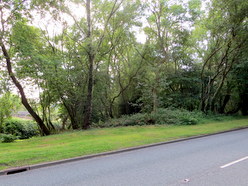
A small block of oak, willow and birch woodland on the south side of Thornford Road. Non-intervention.